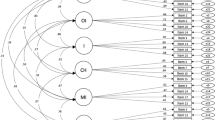Abstract
Hungarian and United States adolescents' self-image was studied using the Offer Self-Image Questionnaire (OSIQ). In Hungary, 1,163 younger and older male and female adolescents were studied using a Hungarian translation of the OSIQ. Analyses of endorsement patterns of OSIQ items showed that Hungarian and American adolescents endorsed many items in the same way. Similarities in endorsement patterns were much more common between the two countries than were differences. Analyses of OSIQ scales showed that for most scales younger Hungarian adolescents reported better adjustment than younger American adolescents. Differences were not as great or reversed in the older age groups. Implications for cross-cultural studies of adolescent self-image were drawn based on these results.
Similar content being viewed by others
References
Agrawal, P. (1978). A cross-cultural study of self-image: Indian, American, Australian, and Irish adolescents.J. Youth Adoles. 7: 107–135.
Brennan, T. G., and O'Loideain, D. S. (1980). A comparison of normal and disturbed adolescent Offer Self-Image Questionnaire responses in an Irisn cultural setting.J. Youth Adoles. 9: 11–17.
Cronbach, L. J. (1970). Essential Psychological Testing, Harper, New York.
Csikszentmihalyi, M., and Larson, R. (1984).Being Adolescent, Basic Books, New York.
Dudley, H. K., Jr., Craig, E. M., and Mason, J. M. (1981). The measurement of adolescent personality dimensions: The MMPI and the Offer Self-Image Questionnaire for Adolescents.Adolescence 16: 453–469.
Erikson, E. H. (1968).Identity, Youth and Crisis, Norton, New York.
Hollos, M. (1975). Logical operations and role-taking abilities in two cultures: Norway and Hungary.Child Dev. 46: 638–649.
Offer, D. (1969).The Psychological World of the Teenager: A Study of Normal Adolescent Boys, Basic Books, New York.
Offer, D., and Howard, K. I. (1972). An empirical analysis of the Offer Self-Image Questionaire for Adolescents.Arch. Gen. Psychiat. 27: 529–537.
Offer, D., and Offer, J. B. (1975).From Teenage to Young Manhood: A Psychological Study, Basic Books, New York.
Offer, D., and Sabshin, M. (eds.) (1984).Normality and the Life Cycle: A Critical Integration, Basic Books, New York.
Offer, D., Ostrov, E., and Howard, K. I. (1977). The self-image of adolescents: A study of four cultures.J. Youth Adoles. 6: 265–279.
Offer, D., Ostrov, E. and Howard, K. I. (1981).The Adolescent: A Psychological Self-Portrait, Basic Books, New York.
Offer, D., Ostrov, E., and Howard, K. I. (1982).The Offer Self-Image Questionnaire for Adolescents: A Manual, Michael Reese Hospital and Medical Center, Chicago, Ill.
Ostrov, E., and Offer, D. (1978). Loneliness and the adolescent. In Feinstein, S. C., and Giovacchini, P. L. (eds.),Adolescent Psychiatry, Vol. VI, University of Chicago Press, Chicago, Ill. [Reprinted in Hartog, J. (ed.),The Anatomy of Loneliness, International Universities Press, New York, 1980].
Ostrov, E., Offer, D., and Howard, K. I. (1986). Cross-cultural studies of sex differences in normal adolescents' self-image.J. Hillside Hosp. (in press).
Pataki, F. (1982).Az én és a társadalmi azonosságtudat, Kossuth Könyvkiadó, Hungary.
Rosenthal, D. A., Moore, S. M., and Taylor, M. J. (1983). Ethnicity and adjustment: A study of the self-image of Anglo-, Greek-, and Italian-Australian working class adolescents.J. Youth Adoles. 12: 117–135.
Schechter, N. L. (1985). Pain and pain control in children.Curr. Problems Pediat. 15: 19–22.
Turner, S. M., and Mo, L. (1984). Chinese adolescents' self-concept as measured by the Offer Self-Image Questionnaire.J. Youth Adoles. 13: 131–143.
Author information
Authors and Affiliations
Additional information
Received M. D. from the Semmelweis Medical university in Budapest. Research interest is complex somato-mental health care of adolescents.
Received M. D. from the University of Chicago. Major interests are concepts of mental health and the developmental psychology of adolescence.
Director, Forensic Psychology, Michael Reese Hospital and Medical Center. Received J. D. from the University of Chicago School of Law; received Ph. D. in human development from the University of Chicago. Research interests are adolescence and delinquency.
Professor of Psychology, Northwestern University. Received Ph. D. in psychology from the University of Chicago. Major interests are psychotherapy research and adolescence.
Rights and permissions
About this article
Cite this article
Kertész, M., Offer, D., Ostrov, E. et al. Hungarian adolescents' self-concept. J Youth Adolescence 15, 275–286 (1986). https://doi.org/10.1007/BF02139127
Received:
Accepted:
Issue Date:
DOI: https://doi.org/10.1007/BF02139127




